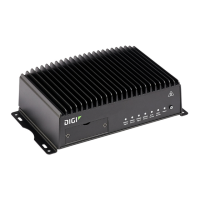Hotspot Hotspot RADIUS attributes
Digi TransPort WR Routers User Guide
139
The /hotspot folder and files are loaded when the hotspot is enabled, and you can restore the default
pages by doing the following:
1. On the menu, click System > File System.
2. Select the /hotspot folder.
3.
Click (Rename) in the toolbar.
4. Enter hotspot_modified and press OK.
5. On the menu, click Network > Services > Hotspot.
6. Disable the hotspot by clicking on the Enable toggle switch.
7. Click Apply.
8. Enable the hotspot by clicking on the Enable toggle switch.
9. Click Apply. The /hotspot folder and sample files are loaded into the file system.
Use a remote webserver
You can use an external webserver for authentication instead of hosting the login webpage on the
router. To use an external webserver, set Login to Remote URL and set Remote URL to the URL of
the login page. The URL should start with http:// or https://. The server hosting the login page, as
well as any supporting servers (for instance, for assets, payment, or social media login), should be
"white listed" by adding them to the Allowed Domains or Allowed Subnets for the hotspot.
Alternately, you can use the command line to make this change. For example, if the login page was
located at http://example.com/login.html, you could use the following commands:
digi.router> hotspot login remote-url
digi.router> hotspot remote-url http://example.com/login.html
digi.router> hotspot allowed-domains example.com
digi.router> save config
The login page on the external server should include ChilliLibrary.js and call the same JavaScript
functions that the sample HTML pages do. While integrating an external server, you can download the
sample HTML pages from the hotspot folder on the router and then upload the sample pages to the
external server for debugging purposes. To make this work, modify the following javascript variables
in the sample HTML page:
Javascript variable Description
hostname Hotspot IP address (for example, 10.1.0.1).
port Hotspot UIserver port (for example, 4990).
host Hotspot IP address and UIserver port number (for example, 10.1.0.1:4990).
Hotspot RADIUS attributes
The RADIUS server may send attributes to the hotspot to affect the operation of a client session. For
example, here are some of the RADIUS attributes that the hotspot handles:
n Session-Timeout
n Idle-Timeout
n Acct-Interim-Interval

